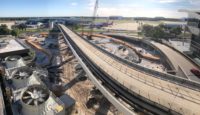Its new international airport notwithstanding, the tiny British territory of St. Helena, which sits in the southern Atlantic Ocean about 2,000 kilometers from the African coast, remains as isolated as it was in 1815, when Napoleon Bonaparte was exiled there after losing the Battle of Waterloo.
Potentially dangerous, erratic winds, discovered just before the United Kingdom government-funded airport was due to open this May, have kept the new 1,850-meter-long runway closed to all but a few special flights.
Until engineers fix the airport, the 4,100 residents’ only way off the island is an aging British mail boat that makes a week-long voyage to South Africa.
“We are currently gathering data about the wind conditions at the airport from which options for mitigation will be developed,” says a St. Helena government spokeswoman.
The U.K. Dept. for International Development (DFID) this summer appointed an external expert to review all the evidence; it plans to establish an independent panel to fix the problem, says a spokeswoman. DFID declined to identify the expert or give a time frame for a solution.
The U.K. aviation authorities were about to certify the new airport when, last April, a test flight revealed potentially dangerous wind shear around the runway. The main issue is the wind’s rapid change in speed and direction.
In light of the roughly 130-sq-km island’s difficult topography, “expert studies as far back as 2004 concluded that the current location for St. Helena Airport was the only viable option,” says the local administration’s spokeswoman.
When determining the location for the airport, the U.K. and St. Helena governments followed recommendations by London-based consultant WS Atkins plc., she adds.
Atkins handled feasibility and other studies for DFID and produced the master plan, confirms a company spokesman. During that work, “a series of risks, consequences and recommendations associated with wind and other weather conditions were highlighted,” he adds. He declined to confirm whether wind shear had been mentioned.
“Wind shear is an unpredictable phenomenon,” according to Sandip Verma, a former DFID minister. In a report to parliament this June, she said that, “during the project management, the U.K. Meteorological Office assessed the probability of wind shear as low.”
South Africa-based Basil Read (Pty.) Ltd., based in Johannesburg, built the airport under a $322-million, four-year contract with DFID; the contract was signed in late 2011. The design-build contract includes 10 years of operations.
Basil Read reports moving 8 million cu m of rock to level the runway. The contractor shipped from Africa 70,000 tons of material, including 22 million liters of diesel, 25,000 tons of cement and 5,000 tons of explosives.







Post a comment to this article
Report Abusive Comment